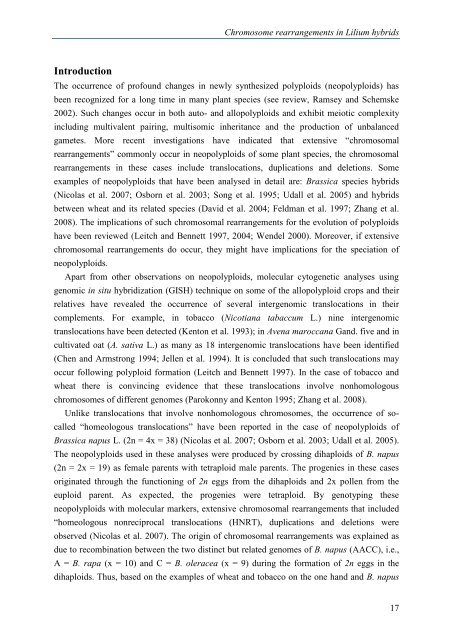A molecular cytogenetic analysis of chromosome behavior in Lilium ...
A molecular cytogenetic analysis of chromosome behavior in Lilium ...
A molecular cytogenetic analysis of chromosome behavior in Lilium ...
You also want an ePaper? Increase the reach of your titles
YUMPU automatically turns print PDFs into web optimized ePapers that Google loves.
Chromosome rearrangements <strong>in</strong> <strong>Lilium</strong> hybridsIntroductionThe occurrence <strong>of</strong> pr<strong>of</strong>ound changes <strong>in</strong> newly synthesized polyploids (neopolyploids) hasbeen recognized for a long time <strong>in</strong> many plant species (see review, Ramsey and Schemske2002). Such changes occur <strong>in</strong> both auto- and allopolyploids and exhibit meiotic complexity<strong>in</strong>clud<strong>in</strong>g multivalent pair<strong>in</strong>g, multisomic <strong>in</strong>heritance and the production <strong>of</strong> unbalancedgametes. More recent <strong>in</strong>vestigations have <strong>in</strong>dicated that extensive “chromosomalrearrangements” commonly occur <strong>in</strong> neopolyploids <strong>of</strong> some plant species, the chromosomalrearrangements <strong>in</strong> these cases <strong>in</strong>clude translocations, duplications and deletions. Someexamples <strong>of</strong> neopolyploids that have been analysed <strong>in</strong> detail are: Brassica species hybrids(Nicolas et al. 2007; Osborn et al. 2003; Song et al. 1995; Udall et al. 2005) and hybridsbetween wheat and its related species (David et al. 2004; Feldman et al. 1997; Zhang et al.2008). The implications <strong>of</strong> such chromosomal rearrangements for the evolution <strong>of</strong> polyploidshave been reviewed (Leitch and Bennett 1997, 2004; Wendel 2000). Moreover, if extensivechromosomal rearrangements do occur, they might have implications for the speciation <strong>of</strong>neopolyploids.Apart from other observations on neopolyploids, <strong>molecular</strong> <strong>cytogenetic</strong> analyses us<strong>in</strong>ggenomic <strong>in</strong> situ hybridization (GISH) technique on some <strong>of</strong> the allopolyploid crops and theirrelatives have revealed the occurrence <strong>of</strong> several <strong>in</strong>tergenomic translocations <strong>in</strong> theircomplements. For example, <strong>in</strong> tobacco (Nicotiana tabaccum L.) n<strong>in</strong>e <strong>in</strong>tergenomictranslocations have been detected (Kenton et al. 1993); <strong>in</strong> Avena maroccana Gand. five and <strong>in</strong>cultivated oat (A. sativa L.) as many as 18 <strong>in</strong>tergenomic translocations have been identified(Chen and Armstrong 1994; Jellen et al. 1994). It is concluded that such translocations mayoccur follow<strong>in</strong>g polyploid formation (Leitch and Bennett 1997). In the case <strong>of</strong> tobacco andwheat there is conv<strong>in</strong>c<strong>in</strong>g evidence that these translocations <strong>in</strong>volve nonhomologous<strong>chromosome</strong>s <strong>of</strong> different genomes (Parokonny and Kenton 1995; Zhang et al. 2008).Unlike translocations that <strong>in</strong>volve nonhomologous <strong>chromosome</strong>s, the occurrence <strong>of</strong> socalled“homeologous translocations” have been reported <strong>in</strong> the case <strong>of</strong> neopolyploids <strong>of</strong>Brassica napus L. (2n = 4x = 38) (Nicolas et al. 2007; Osborn et al. 2003; Udall et al. 2005).The neopolyploids used <strong>in</strong> these analyses were produced by cross<strong>in</strong>g dihaploids <strong>of</strong> B. napus(2n = 2x = 19) as female parents with tetraploid male parents. The progenies <strong>in</strong> these casesorig<strong>in</strong>ated through the function<strong>in</strong>g <strong>of</strong> 2n eggs from the dihaploids and 2x pollen from theeuploid parent. As expected, the progenies were tetraploid. By genotyp<strong>in</strong>g theseneopolyploids with <strong>molecular</strong> markers, extensive chromosomal rearrangements that <strong>in</strong>cluded“homeologous nonreciprocal translocations (HNRT), duplications and deletions wereobserved (Nicolas et al. 2007). The orig<strong>in</strong> <strong>of</strong> chromosomal rearrangements was expla<strong>in</strong>ed asdue to recomb<strong>in</strong>ation between the two dist<strong>in</strong>ct but related genomes <strong>of</strong> B. napus (AACC), i.e.,A = B. rapa (x = 10) and C = B. oleracea (x = 9) dur<strong>in</strong>g the formation <strong>of</strong> 2n eggs <strong>in</strong> thedihaploids. Thus, based on the examples <strong>of</strong> wheat and tobacco on the one hand and B. napus17














